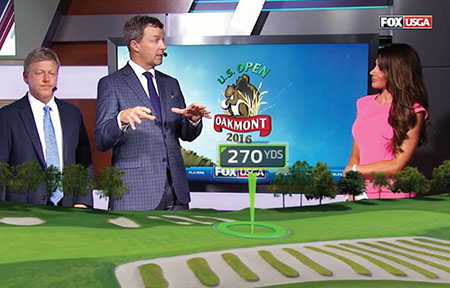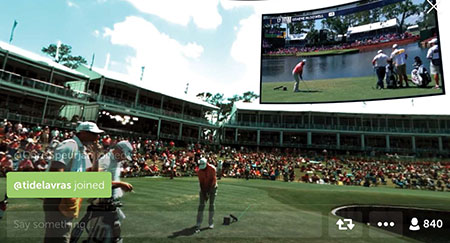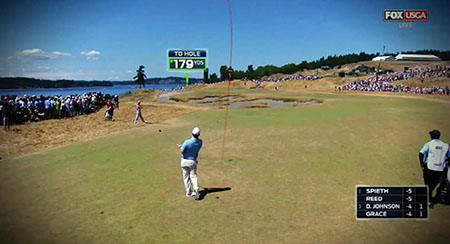Pro Golf Tees Up New Tech
OTTAWA—Televised professional golf is quickly adapting the latest graphic enhancements to give fans the ultimate in immersive and information-rich experiences.
At this month’s U.S. Open Championship, Fox Sports deployed a 75-foot Strada Camera Crane to enable augmented reality graphic elements to be displayed on course, as well as a studio jib for analysis in a studio setting. To increase its shot-tracing efforts, Fox Sports equipped all 18 holes with tracing ability with either live video or through a graphic representation of the hole. Nine tee boxes used Toptracer technology, allowing for live ball trace over video. The remaining tee boxes were equipped with Trackman radar for a combination of ball tracing and enhanced data.

Augmented reality was used to enhance Fox Sports’ coverage of the U.S. Open earlier this month.
A total of 216 microphones were deployed to capture audio and—like last year—three holes were shown in 4K on DirecTV.
VIRTUALLY THERE
The AI technology used at golf’s most recent Major is the latest example of how graphics and video technology are revolutionizing televised coverage of the sport.
With the aid of live virtual reality and live 360 video, PGA Tour fans got to literally immerse themselves into the 17th hole action of The Players Championship last month.
Using three different live VR camera feeds from the Stadium Course at TPC Sawgrass in Ponte Vedra Beach, Fla., the PGA Tour virtually beamed wearers of Samsung Gear VR headsets (connected to Samsung Galaxy smartphones) onto the 17th green, giving 180-degree-horizontal/60-degree-vertical views as play progressed. (To see the Live VR stream of #17 from The Players, viewers had to download the PGA Tour VR Live App from the Oculus Store and install it on their Galaxy smartphone.)
Get the TV Tech Newsletter
The professional video industry's #1 source for news, trends and product and tech information. Sign up below.
Additionally, and for the first time in sports, viewers without a VR headset were able to experience the same live content, via live 360 video offered via the PGA Tour’s Twitter and Periscope accounts.

The view through the Samsung Gear VR goggles at The Players 17th hole.
“The experience on the VR headset was very feature-rich,” said Chris Wandell, senior director of media business development for the PGA Tour. “In addition to the virtual reality video, the Live VR app had a live Leaderboard graphic that could be toggled in and out of view. It also had an Active Tracker that told you which players were currently playing the hole.”
The Gear VR and Twitter/Periscope feeds also included an additional live “Picture In Picture” video feed at the top of the viewing window, which was perfectly synced to the VR action and included highlights and updates from the tournament. Both the Gear VR and 360-video feeds were available worldwide.
Virtual reality is just one of the 2017 golf season’s big tech stories. The sport—which has been a perennial favorite on network broadcast television—is also increasing its online presence to enhance the broadcasts.
This year’s VR coverage is a culmination of two years of preparation, according to Wandell. “We did our first VR test of non-live content back in 2015, and we’ve been experimenting very regularly,” he said. Still, this year’s live VR stream from The Players represents another big step in the PGA Tour’s efforts to offer more than conventional coverage.
A case in point: For the first time ever, the PGA Tour placed three of Intel’s True VR stereoscopic cameras at TPC’s 17th hole: one located on the tee, a second on the walkway from the tee box to the green, and the third in the water, less than 15 feet off of the “island” green. This meant that VR viewers could literally “beam” from one camera position to another as the live play evolved around them.
“If VR viewers didn’t want to switch cameras themselves, they could leave it to us and watch the VRCast on their Gear VR headsets, with Intel’s mobile unit handling the switching between the three cameras,” said Wandell.
Reaction was very positive. “Everybody was pretty floored by what they saw, based on the comments we’ve received,” Wandell said. “We also know that our numbers were up significantly from what we expected, so we are exploring additional Live VR events in the future.”
STREAMING FINDS ITS BALANCE
The PGA Tour certainly wowed viewers with VR at The Players, but streaming PGA video is also big news; specifically in the way that U.S. broadcasters are employing streaming to enhance, not undercut, their primary on-air product.

One of Fox Sport’s streaming channels electronically tracks the motion of the ball.
Photo Credit: Fox Sports
“We are simulcasting our golf coverage across multiple platforms, but TV is the undisputed star,” said Clark Pierce, senior vice president, TVE & special projects, product development for Fox Sports. “Streaming is certainly being used to provide extra content to our audiences, but streaming doesn’t cut into our broadcast viewership because TV is where the biggest picture is—and our viewers prefer to watch the biggest picture whenever they can.”
“Our goal is to provide the best coverage to golf viewers, regardless of whatever device they are watching us on,” said Will McIntosh; senior vice president of business and strategy for Golf Channel (part of the NBC Sports Group, and producer of golf coverage for both Golf Channel and NBC Sports). “But since viewers still prefer to watch us on the big screen, that’s where our focus is.”
(Note: For live tournament coverage airing on both Golf Channel and NBC, a single on-site crew oversees production for both Golf Channel—Thursday and Friday and early in the day on the weekends—as well as coverage airing on NBC on Saturday and Sunday afternoons.)
The fact that streaming is a supporting player does not make it unimportant to either Fox Sports or Golf Channel. But streaming’s supporting role does limit the kind of content both broadcasters are paying to put online: You don’t spend the same kind of money on a supporting actor as you do on a star.
This is why Fox Sports and Golf Channel fill their streaming channels with video provided by their existing broadcast production units, rather than new standalone content. Specifically, both are streaming live camera feeds that are not necessarily part of the primary broadcast program; in addition to simulcasting the primary broadcast program online.
At Golf Channel, “our streaming channels are providing coverage of a featured group throughout an entire round, plus ongoing camera views of specific holes,” said McIntosh. Fox Sports features two streaming channels that cover two selected groups, and another that covers a specific hole or holes, according to Pierce. “We are also working on a fourth stream that includes a wealth of graphical features such as ‘tracer’ shots, which illustrate how the balls travelled on the course.”
James Careless is an award-winning journalist who has written for TV Technology since the 1990s. He has covered HDTV from the days of the six competing HDTV formats that led to the 1993 Grand Alliance, and onwards through ATSC 3.0 and OTT. He also writes for Radio World, along with other publications in aerospace, defense, public safety, streaming media, plus the amusement park industry for something different.

